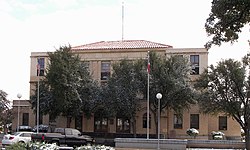Reeves County, Texas
| Reeves County, Texas | |
|---|---|

Reeves County Courthouse in Pecos
|
|
 Location in the U.S. state of Texas |
|
 Texas's location in the U.S. |
|
| Founded | 1884 |
| Named for | George R. Reeves |
| Seat | Pecos |
| Largest city | Pecos |
| Area | |
| • Total | 2,642 sq mi (6,843 km2) |
| • Land | 2,635 sq mi (6,825 km2) |
| • Water | 6.7 sq mi (17 km2), 0.3% |
| Population (est.) | |
| • (2015) | 14,732 |
| • Density | 5.2/sq mi (2/km²) |
| Congressional district | 23rd |
| Time zone | Central: UTC-6/-5 |
| Website | www |
Reeves County is a county located in the U.S. state of Texas. As of the 2010 census, its population was 13,783. Its county seat is Pecos. The county was created in 1883 and organized the next year. It is named for George R. Reeves, a Texas state legislator and colonel in the Confederate Army. It is one of the nine counties that comprise the Trans-Pecos region of West Texas.
Reeves County comprises the Pecos, TX Micropolitan Statistical Area.
Prehistoric Clovis culture peoples in Reeves County lived in the rock shelters and caves nestled near water supplies. These people left behind artifacts and pictographs as evidence of their presence.Jumano Indians led the Antonio de Espejo 1582–1583 expedition near Toyah Lake on a better route to the farming and trade area of La Junta de los Ríos. Espejo's diary places the Jumano along the Pecos River and its tributaries. The Mescalero Apache frequented San Solomon Springs to irrigate their crops. In 1849 John Salmon "RIP" Ford explored the area between San Antonio and El Paso noting in his mapped report the productive land upon which the Mescalero Indians farmed.
The state legislature formed Reeves from Pecos County in 1883, and named it after Texas legislator and soldier George Robertson Reeves. The county was organized in 1884. The town of Pecos was named as county seat.
...
Wikipedia
